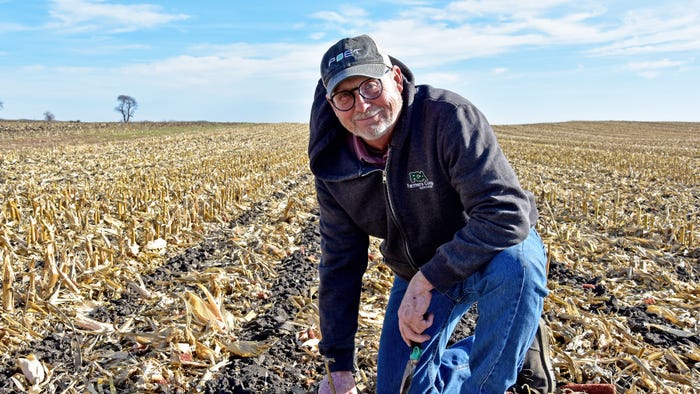January 23, 2024

Conservation and technology go hand in hand for Mark Kingland of Forest City, Iowa. Tech tools such as yield monitors help him decide where to locate conservation practices. He also uses a drone to plant cover crop seed, which helps address natural resource concerns on his cropland.
Kingland, who farms nearly 1,800 acres throughout the north-central Iowa county of Winnebago with his brother, Tom, seeded several hundred cover crop acres for the first time last fall. He used his new drone to broadcast the seed. Kingland flew the drone about 12 feet above the corn canopy in September, applying a turnip, cereal rye, annual ryegrass, radish and hairy vetch seed mix.
Kingland also sprayed fungicide with his drone. “It’s the neatest thing to use,” he says. “After you've calibrated it, you send the drone on its way. The application is very accurate, consistent, and all information is mapped and recorded for my permanent records.”
Although Kingland never grew cover crops before, he knew he could get a better cover crop stand by applying seed with a drone instead of a plane.
“The drone application really forces the seed down through the canopy, while a plane-applied seed just floats down and often produces an uneven stand,” he says.
In his first fall growing cover crops, Kingland flew his five-seed mix on 190 acres. To help offset the initial cover crop expense, Kingland uses funding assistance through the Cedar River Source Water Partnership project — a Regional Conservation Partnership Program (RCPP) watershed project led by the city of Cedar Rapids and administered by USDA’s Natural Resources Conservation Service.
He also used his drone to seed 90 acres of field pea cover crops on a different farm with cost-share assistance through the Iowa Department of Agriculture and Land Stewardship.
‘Nutrient elevator’
A former agronomist, Kingland calls the work that cover crops perform as a “nutrient elevator.”
“I don’t think cover crops are promoted enough from an agronomic standpoint,” he says. “Cover crop roots go down and extract nutrients from what has been applied, and the cover crops bring the nutrients up to be available for the next crop I put in.”
Many farmers who try cover crops for the first time start with a single species, such as cereal rye. But Kingland wants multiple benefits from the cover crops, such as an increase in crop yields and a decrease in herbicide and fertilizer needs.
“The multi-species mix costs more, but I want this to work and accomplish something agronomically,” he says. “The way I look at it, when the cost-share runs out, I’ll be making that money back in agronomic benefits.”
Use of prairie strips
Areas of low-yielding cropland show up in bright red on Kingland’s yield monitor maps. Josiah Olson, NRCS district conservationist, works with Kingland to target conservation practices for those red areas. Olson recommended vegetative cover in the form of prairie strips for those spots where Kingland says he is losing money.
Prairie strips are small patches and strips of native prairie in farmland that include a mix of 25 to 30 seed types. Benefits of prairie strips include:
reduced sediment delivery
increased biodiversity
improved wildlife habitat
Olson says prairie strips make a lot of sense along timber lines where cash crops get shaded, compete for water and attract wildlife. Kingland says these “odd” crop rows that are difficult to spray and manage are excellent spots for prairie strips.
“Deer just devastate the first 12 rows on the edge of a field,” Kingland says. “I’m hoping by adding some habitat that deer will concentrate more in that area than my crops.”
“Near terraces where the soil has been compacted and worked over for years also make good prairie strip locations,” Olson says. He adds that prairie strips are available for federal funding through the Conservation Reserve Program and the Environmental Quality Incentives Program.
Kingland chose a five-year EQIP contract that pays $434 per acre annually for his 2.7 acres of prairie strips.
“I’m positioning the prairie strips where I’m not making money farming, so to put prairie strips in a program like EQIP is fantastic,” Kingland says. “I’m continuing to look at other areas where it makes sense to add prairie strips.”
Olson says EQIP and RCPP pay a higher rate than CRP because the contract holder is responsible for paying the seed and installation costs.
Kingland says he has appreciated working with NRCS’ Olson. “Josiah understands that I have to make money, so I look at the programs he’s recommending as a bridge to changing the way I operate,” he says.
Trying strip till
For the first time this year, Kingland is strip-tilling his cropland instead of lightly tilling as he did in past years. In strip till, the soil and residue are left undisturbed from harvest to planting except for strips up to a third of the row width. Strips are cleared of residue and tilled for warming and drying before or during fall planting.
Strip till is popular in north-central Iowa where soils tend to be wet and cold, and drain poorly, which delays seed germination.
Just as he did with cover crops, Kingland says he switched to strip till primarily for agronomic purposes.
“Getting the fertilizer down where the crop can use it is essential,” he says. “If I can get fertilizer down 4 to 6 inches, with the residue between the rows, it conserves moisture. Last year, that made a big difference.”
With so many changes in a short time, Kingland says he’s likely to make some mistakes. “I’ll learn from them, but this is a good transition to where we want to be,” he says.
For more information about conservation practices and programs to treat natural resource concerns on your land, visit your local NRCS office or go to nrcs.usda.gov/ia.
About the Author(s)
You May Also Like




